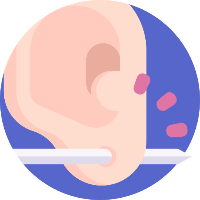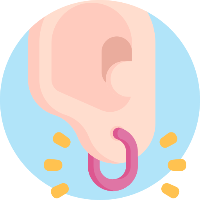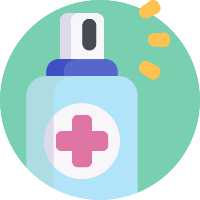Piercing Aftercare: Tips and Tricks for Healing and Maintenance
- Hannah Hutchins
- Mar 30, 2024
- 3 min read
Updated: Aug 19
Piercings have long been a form of self-expression and adornment, dating back centuries across various cultures. Proper aftercare is crucial to ensure a smooth healing process and prevent infections.
Before we go any further keep in mind the aftercare isn’t healing our piercings, our bodies are doing all the work. Proper Aftercare is crucial for our piercings to heal safely because it sets the stage for our body to recover.

Timeline
Most piercings take anywhere from 3-9 months to heal. Some piercings may even take longer. Healing is a process that often fluctuates depending on your body and your lifestyle. If you catch a cold or the flu during the healing process or you catch your jewelry on something irritating the piercing this may lengthen your healing time.

What to expect
In the beginning stages of healing you can expect some bleeding, swelling, tenderness and even bruising around the pierced area.
As your piercing continues to heal you may notice an increase of secretions and fluids; this may leave dry crust around your piercing. You may also notice dark spots, or hyperpigmentation around your piercing as it heals, this is also normal.
Once your body has healed the tissue outside of your piercing it may feel like your piercing is completely healed. However your body is likely still healing around the jewelry on the inside of your piercing. It is important to continue cleaning your piercing and not to change your jewelry throughout the entire healing process.

Aftercare instructions
Keep Your Hands Clean
Before touching your new piercing, wash your hands thoroughly with soap and water. Avoid touching the piercing unnecessarily, as this can introduce bacteria and increase the risk of infection.
Apply Saline Solution
To clean your new piercing it is recommended to spray with Saline Solution. 2-3 times per day.
“Mixing your own sea salt solution will commonly result in the product being far too salty and strong, this can over dry the piercing and interfere with healing” - APP
When choosing your Saline solution you should pay attention to the ingredients listed. You're looking for a solution where the only active ingredient is .09% sodium chloride.
Keep in mind, Saline isn’t healing your piercing, your body is. So If you do not have access to saline solution you can use clean, filtered water. If you chose to use water it is very important to use clean water.
Dry your Piercing
When Drying you can gently remove any crusty buildup with a cotton swob. Excessive moisture can cause irritation and prolong the healing process.

Things to Avoid
Swimming:
Stay out of pools, hot tubs, and natural bodies of water like lakes and oceans until your piercing is fully healed. These environments harbor bacteria and other pathogens that can lead to infections.
Harsh Chemicals / Cosmetic products
Avoid using alcohol, hydrogen peroxide, or other harsh chemicals on your piercing, as they can irritate the skin and delay healing. It is also important to avoid lotions, Makeup, and perfumes around the pierced area.
“Avoid Bactine®, pierced ear care solutions, and other products containing Benzalkonium Chloride (BZK). These can be irritating and are not intended for long-term wound care” - APP
Twisting / Rotating your jewelry.
It’s important to limit the amount of trauma to the piercing especially during the healing process. Excessive motion to the area can prolong healing and cause other issues such as piercing migration and growth or excess scar tissue.
Sleeping on your piercing
For ear piercings, sleeping directly on the piercing can cause irritation and can even shift the piercings angle during the healing process which could lead to piercing migration. It is also important to maintain clean bedding as not to Introduce bacteria and other unwanted debris into your piercing as you sleep.
Watch for Signs of Infection:
Keep an eye out for signs of infection, such as excessive redness, swelling, pain, heat, or discharge that is yellow, green, or foul-smelling. If you suspect an infection, seek medical attention promptly.

In conclusion
Proper aftercare is essential for ensuring the successful healing of your piercing and reducing the risk of complications. By following these guidelines and listening to your piercer's advice, you can enjoy your new piercing with minimal discomfort and maximum style. Remember, if you have any concerns or questions during the healing process, don't hesitate to reach out to your piercer or a healthcare professional for guidance




